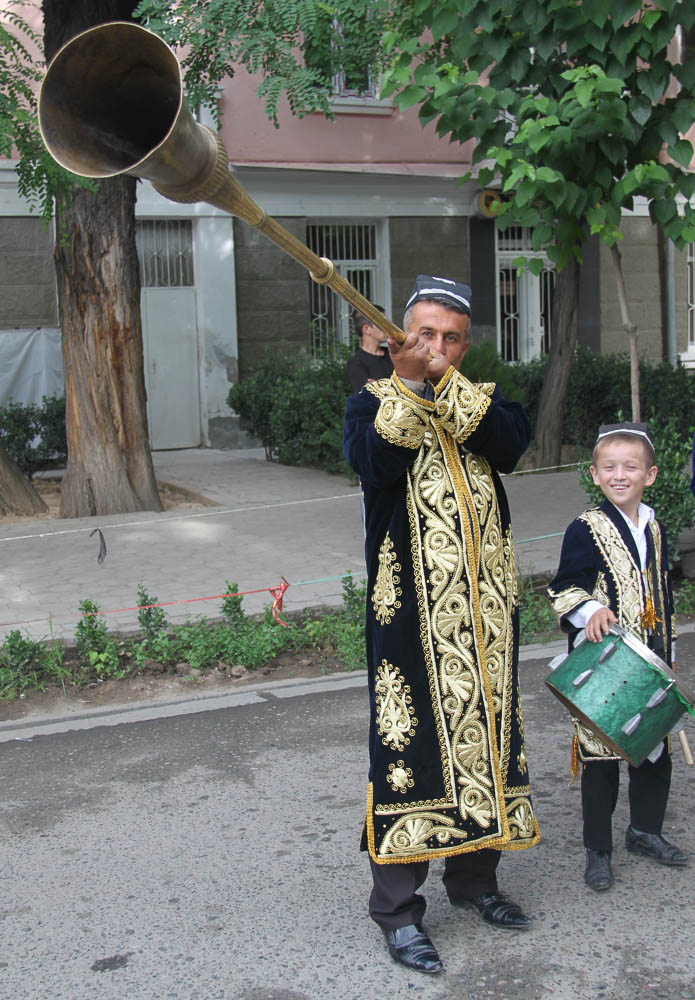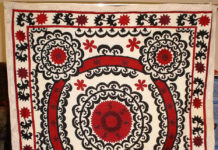
One of the most common types of decorative and applied arts of the Tajiks is zarduzi goldwork. The art of golden-stitch embroidery in Tajikistan has deep roots. It flourished during the reign of the founder of the Tajik nation, Ismail Somoni, and was considered an official court art. His court enjoyed artfully embroidered blankets from silk fabrics and rich curtains and tents embroidered with gold. Gold embroidery was used on silk, on fabrics made from monochrome velvet, as well as on leather and fur. Male and female clothes were richly decorated with gold embroidery as well.
Tajiks used three types of gold embroidery:
1. Zarduzi (embroidery with a stencil)
2. Zaminduzi (embroidery on smooth surface without stencil)
3. Bireshimduzi (embroidery using gold and silk threads)
In gold embroidery, there are basically two types of ornament: floral and geometric, with all sorts of variations. Each element of the pattern has its own name and often serves as an amulet. Gulduzi is an ornament, created on the basis of the drawing applied to the material. This style is one of the most difficult in gold embroidering. Gulduzi embroidery was used in robes, chapan jackets, shoes for the bride, boskat, skullcaps, horse attire. Gold and silver threads were used. Due to its splenduor and high cost of materials, gold embroidery was an official court art designed to serve the needs of the Emir’s court and the nobility. By order of Emir and his court, men’s clothing, embroidered with gold, was made and included gowns, camisoles, uniforms, trousers, shoes, belts, hats, and even horse cloth. Decorative elements included oftob (sun), bulbul (nightingale), guncha (buds), sadbarg (rose), gulshan (flower garden), chashmi bulbul (eye of nightingale), and mavj (wave).
At present, with the revival of national traditions and handicrafts, gold embroidery is gaining new life. Gold embroidered men’s robes became an obligatory part of groom’s wedding outfit. They are worn in special occasions and are presented to honorable guests. Women’s short and long waistcoats and gold-embroidered skullcaps are widespread. Golden-stitch embroidery is used to decorate shoes, belts and handbags. Now this kind of art is mainly produced by women. As before, the basis is a smooth surface velvet of bright colors, which gives the products special efficiency.

Mukarrama Kayumova and her students, embroiderers Karimova Surayo, Khasanova Dilbar and Kurbonalieva Lutfiya, have all played vital role in training and upbringing new craftsmen and the revival of gold embroidery in Tajikistan. Their embroidered women’s and men’s robes, camisoles, ritual suits of bride and groom, skullcaps, shoes and interior décor items received state awards and entered the book Golden Fund of Tajikistan.
zarduzi – gold embroidery (two kinds of thread – golden and white, used in finishing velvet); zaminduzi (multi-colored ornamentation, pattern all over the fabric); gulduzi (ornament is created on the basis of the pattern drawn on the fabric) This embroidery is used for gowns, chapans, shoes for the bride, boskat, skullcaps, horse attire and is most often used in modern gold-stitch embroideries.
Mainly used techniques are zarduzi-zaminduzi (full embroidery of the background with gold) and zarduzi-gulduzi (patterned floral embroidery). In addition, zarduzi-gulduzi-zaminduzi (combined embroidery technique), zarduzi-berishimduzi (embroidery where motifs stitched with silk alternate with gold patterns), and zarduzi-pulyakchaduzi in which gold embroidery is combined with sewn sequins.




